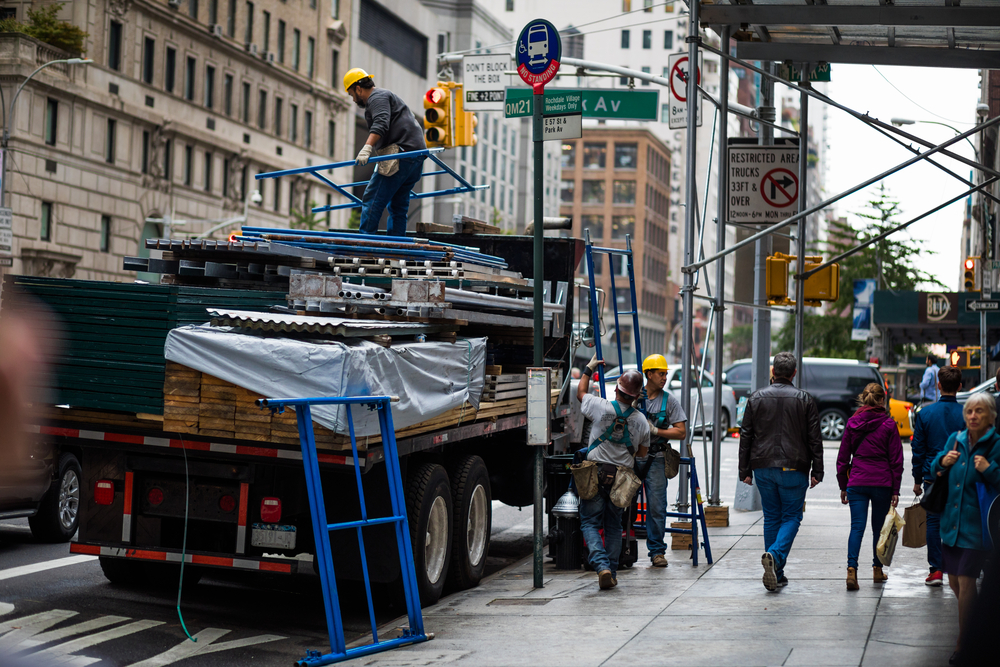Earlier this month, a sidewalk shed—commonly known as scaffolding—collapsed onto a busy SoHo street in New York City, injuring five pedestrians, one of them seriously. According to Pix11.com, the shed had been in place since December 2016, shielding a 12-story commercial building undergoing facade repairs. Reports suggest that wind gusts of up to 40-45 mph, funneled through an “urban wind tunnel,” may have contributed to the collapse.
The Hidden Risks of NYC Sidewalk Sheds
While pedestrian accident statistics in New York City often focus on vehicle-related incidents, scaffolding collapses are a less publicized yet ongoing hazard. This SoHo incident is part of a troubling history of sidewalk shed failures. According to The New York Times, 55 pedestrians were killed by scaffolding collapses in just the first six months of 2016. Meanwhile, Crain’s New York reported in 2016 that NYC had around 190 miles of sidewalk sheds—enough to encircle Manhattan six times.
Why Are Sidewalk Sheds Everywhere in NYC?
According to the Department of Buildings, New York City has nearly 9,000 sidewalk sheds. While these structures are intended to protect pedestrians from falling debris, they are often viewed as dangerous eyesores. They consume sidewalk space, reduce sunlight, and hurt local businesses.
The prevalence of sidewalk sheds stems from a 1980 law requiring regular inspections of older buildings to ensure structural integrity. Under the Building Facade Safety Program, buildings six stories or taller must be inspected by licensed architects or engineers who submit safety reports to the city. While these laws aim to enhance pedestrian safety, they’ve also fueled a $1 billion scaffolding industry.
Are Sidewalk Sheds Really Keeping Pedestrians Safe?
NYC laws mandate that sidewalk sheds support at least 300 pounds per square foot—double the load capacity required in other cities. This ensures they can absorb the impact of debris, such as a brick falling from 20 stories up. However, the structural demands mean the sheds require columns every eight feet, creating narrow, congested walkways.
Ironically, these “safety structures” often increase risks for pedestrians. Limited sidewalk space forces many to walk in the street, where they face dangers from cars, buses, and bicycles. Sheds also accumulate trash, attract pigeons, and sometimes become shelters for homeless individuals—all of which create additional hazards.
Even law enforcement has felt the impact. In one notable case, a police officer chasing a suspect in 2007 was injured after colliding with a shed pole in the dark.
Why Sidewalk Sheds Never Seem to Disappear
For many NYC residents and business owners, the most frustrating aspect of sidewalk sheds is their persistence. Once erected, they often remain indefinitely. In 2015, the de Blasio administration removed eight miles of inactive sheds from New York City Housing Authority properties. However, no such law applies to private buildings.
Private property owners often find it cheaper to maintain a sidewalk shed and pay violation fines than to fix their buildings. Erecting a shed costs about $25,000, with $700 in monthly maintenance fees, compared to the $250,000 or more required for facade repairs.
Pedestrian Injuries and Legal Protections
Though sidewalk sheds are relatively safe for construction workers, they pose significant risks to pedestrians. According to the Department of Buildings, only 11 of the 199 construction accidents reported in the first half of 2015 involved sidewalk sheds, with no fatalities. However, when accidents do occur, pedestrians bear the brunt of injuries.
New York Labor Law 240/241, also known as the Scaffold Law, holds property owners and contractors fully liable for scaffold-related accidents, regardless of whether the injured pedestrian was partially at fault. This law ensures that victims have legal recourse to seek compensation for their injuries.
Injured in a Sidewalk Shed Accident? Staver Accident Injury Lawyers, P.C. Can Help
If you’ve been injured in a sidewalk shed or scaffolding accident in New York City, you have rights—and Staver Accident Injury Lawyers, P.C. is here to protect them. Navigating the legal landscape after a pedestrian accident can be overwhelming, especially when dealing with complex liability issues involving property owners and construction companies.
Contact us today at (212) 490-5700 or fill out our online contact form for a free, no-obligation consultation. Let us handle the legal process while you focus on your recovery.

